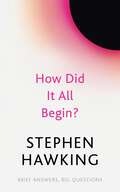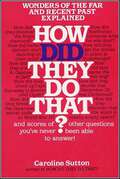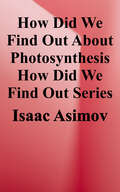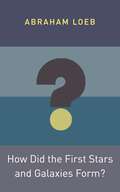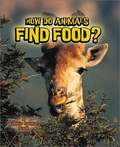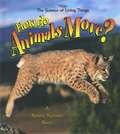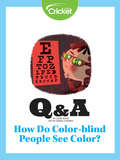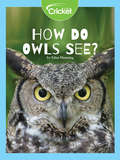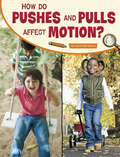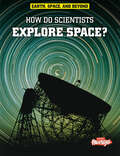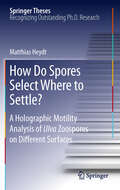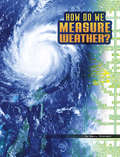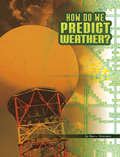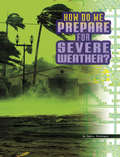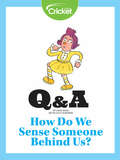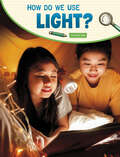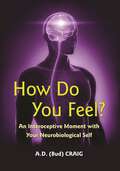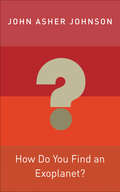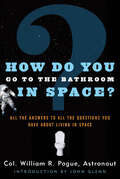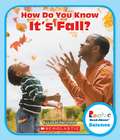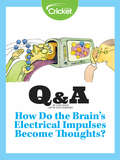- Table View
- List View
How Did It All Begin? (Brief Answers, Big Questions)
by Stephen Hawking'Remember to look up at the stars and not down at your feet'How did it all begin?Is there a God?Throughout his extraordinary career, Stephen Hawking expanded our understanding of the universe and unravelled some of its greatest mysteries. In How Did It All Begin? the world famous cosmologist and bestselling author of A Brief History of Time explores the fundamental questions of our existence.'A brilliant mind' Daily TelegraphBrief Answers, Big Questions: this stunning paperback series offers electrifying essays from one of the greatest minds of our age, taken from the original text of the No. 1 bestselling Brief Answers to the Big Questions.
How Did They Do That?
by Caroline SuttonThe totally satisfying answers to more than 100 questions that drive normal people—not to mention infomaniacs and trivia buffs—crazy.Questions about matters great and small, from ancient times to yesterday.Illustrated with illuminating technical drawings and unusual vintage photographs.How did they spend $40 million making Heaven's Gate?How did they decide the length of a mile?How did Beethoven compose when he was deaf?How did they discover the Hope diamond?How did they know the size of the Earth over 1,700 years before anyone sailed around it?How did they set the price of the Louisiana Purchase?How did the FBI devise the "Ten Most Wanted" list?How did they decide which horses were Thoroughbreds?How did they pick the Four Hundred?How did they start the Guiness Book of World Records?How did the Indians decide that cows were sacred?How did they discover penicillin?How did they build the Great Pyramid at Giza?How did they decide how tall to make the Empire State Building?How did they know there was an El Dorado?How did they start the Chicago fire of 1871?How did Hannibal cross the Alps?
How Did We Find Out About Photosynthesis? (How Did We Find Out About…)
by Isaac AsimovTraces the scientific discoveries that led to our understanding of photosynthesis and how this process relates to the food supply, changing ecological balance, and threats to the Earth's atmosphere.
How Did the First Stars and Galaxies Form? (Princeton Frontiers in Physics #1)
by Abraham LoebA concise introduction to cosmology and how light first emerged in the universeThough astrophysicists have developed a theoretical framework for understanding how the first stars and galaxies formed, only now are we able to begin testing those theories with actual observations of the very distant, early universe. We are entering a new and exciting era of discovery that will advance the frontiers of knowledge, and this book couldn't be more timely. It covers all the basic concepts in cosmology, drawing on insights from an astronomer who has pioneered much of this research over the past two decades.Abraham Loeb starts from first principles, tracing the theoretical foundations of cosmology and carefully explaining the physics behind them. Topics include the gravitational growth of perturbations in an expanding universe, the abundance and properties of dark matter halos and galaxies, reionization, the observational methods used to detect the earliest galaxies and probe the diffuse gas between them—and much more.Cosmology seeks to solve the fundamental mystery of our cosmic origins. This book offers a succinct and accessible primer at a time when breathtaking technological advances promise a wealth of new observational data on the first stars and galaxies.Provides a concise introduction to cosmologyCovers all the basic conceptsGives an overview of the gravitational growth of perturbations in an expanding universeExplains the process of reionizationDescribes the observational methods used to detect the earliest galaxies
How Do Animals Find Food?
by Bobbie KalmanWith so many species competing for food, animals have developed fascinating methods of finding the food that keeps them fat and happy. How do animals find food? Lets children in on such techniques as pack and solitary hunting, and poisonous animals.
How Do Animals Move?
by Bobbie Kalman Niki WalkerSlithering snakes, jumping kangaroos, flying albatrosses, and swimming salmon--every animal, including humans, has its own unique way of getting around. This beautiful new book explains the how, why, and "are we there yet?" of animals large and small across the globe. Topics include: *how an animal's environment affects its movement *how an animal's skeleton affects its movement *unusual animal movers such as the water-walking basilisk *how a parent helps its young move around
How Do Apples Grow (Lets read-and-find-out Science #Stage 2)
by Betsy MaestroDescribes the life cycle of an apple from its initial appearance as a spring bud to that point in time when it becomes a fully ripe fruit.
How Do Color-blind People See Color?
by Lizzie WadeTo understand what it means to be color-blind, you must first understand how most of us see color.
How Do Owls See?
by Edna ManningOwl eyes function much like human eyes but with some small differences.
How Do Pushes and Pulls Affect Motion? (Science Inquiry)
by Lisa M. SimonsYou push your friend while they swing. You pull open a door. What happens when you push or pull an object? Let’s investigate pushing and pulling forces!
How Do Spores Select Where to Settle?
by Matthias HeydtIn this thesis, Matthias Heydt applies digital in-line holography to achieve for the first time a complete three dimensional and real time motion analysis of Ulva zoospores, both in solution and in the vicinity of different surfaces. These results provide previously unknown information about the behavior and mechanism spores use to select a suitable site for settlement. This work gives deeper insight into biofouling algae and stimulates new design strategies for antifouling coatings. Furthermore, the tracking system developed during this research could be used as a new system for assessing the antifouling performance on different surfaces at very early points in time, allowing disentanglement of surface conditioning and interaction of spores with pristine chemistries.
How Do We Classify Materials? (Science Inquiry)
by Yvonne PearsonScientists put things into groups so they are easier to study. Materials have different properties. What are they, and how they are grouped? Let’s investigate materials!
How Do We Know What Information Sharing Is Really Worth?: Exploring Methodologies to Measure the Value of Information Sharing and Fusion Efforts
by Brian A. JacksonHow Do We Know What Information Sharing Is Really Worth?: Exporing Methodologies to Measure the Value of Information Sharing and Fusion Efforts (Research Reports)
How Do We Measure Weather? (Discover Meteorology)
by Nancy DickmannHow fast is the wind blowing? How much moisture is in the air? Meteorologists measure weather conditions to help answer these and other questions. Learn about the tools and systems they use. Find out how these measurements help people plan their days and prepare for any weather.
How Do We Predict Weather? (Discover Meteorology)
by Nancy DickmannWill tomorrow be cold or warm? Cloudy or sunny? Wet or dry? Meteorologists make predictions about how weather conditions will change. Find out how they do it and what challenges they face in trying to help people prepare for coming weather conditions.
How Do We Prepare for Severe Weather? (Discover Meteorology)
by Nancy DickmannA storm is coming! How do people prepare? What supplies and tools do we need to survive? Find out how people prepare for all kinds of severe weather. From tornadoes to hurricanes and blizzards to floods, we can be ready for anything.
How Do We Sense Someone Behind Us?
by Lizzie WadeHow do humans sense when someone is behind them? This Q & A explains the science of peripheral vision.
How Do We Use Light? (Science Inquiry)
by Emily RaijLight is all around us. What is light? Where does it come from? How does it help us see? Readers investigate and read straightforward text accompanied by vibrant photos to learn all about light.
How Do Weather And Climate Affect Our Lives?: Student Activity Guide
by The Smithsonian InstitutionNIMAC-sourced textbook
How Do You Feel?: An Interoceptive Moment with Your Neurobiological Self
by A. D. CraigA book that fundamentally changes how neuroscientists and psychologists categorize sensations and understand the origins and significance of human feelingsHow Do You Feel? brings together startling evidence from neuroscience, psychology, and psychiatry to present revolutionary new insights into how our brains enable us to experience the range of sensations and mental states known as feelings. Drawing on his own cutting-edge research, neurobiologist Bud Craig has identified an area deep inside the mammalian brain—the insular cortex—as the place where interoception, or the processing of bodily stimuli, generates feelings. He shows how this crucial pathway for interoceptive awareness gives rise in humans to the feeling of being alive, vivid perceptual feelings, and a subjective image of the sentient self across time. Craig explains how feelings represent activity patterns in our brains that signify emotions, intentions, and thoughts, and how integration of these patterns is driven by the unique energy needs of the hominid brain. He describes the essential role of feelings and the insular cortex in such diverse realms as music, fluid intelligence, and bivalent emotions, and relates these ideas to the philosophy of William James and even to feelings in dogs.How Do You Feel? is also a compelling insider's account of scientific discovery, one that takes readers behind the scenes as the astonishing answer to this neurological puzzle is pursued and pieced together from seemingly unrelated fields of scientific inquiry. This book will fundamentally alter the way that neuroscientists and psychologists categorize sensations and understand the origins and significance of human feelings.
How Do You Find an Exoplanet?
by John Asher JohnsonAlien worlds have long been a staple of science fiction. But today, thanks to modern astronomical instrumentation and the achievements of many enterprising observational astronomers, the existence of planets outside our solar system--also known as exoplanets--has moved into the realm of science fact. With planet hunters finding ever smaller, more Earth-like worlds, our understanding of the cosmos is forever changed, yet the question of how astronomers make these discoveries often goes unanswered.How Do You Find an Exoplanet? is an authoritative primer on the four key techniques that today's planet hunters use to detect the feeble signals of planets orbiting distant stars. John Johnson provides you with an insider's perspective on this exciting cutting-edge science, showing how astronomers detect the wobble of stars caused by the gravitational tug of an orbiting planet, the slight diminution of light caused by a planet eclipsing its star, and the bending of space-time by stars and their planets, and how astronomers even directly take pictures of planets next to their bright central stars.Accessible to anyone with a basic foundation in college-level physics, How Do You Find an Exoplanet? sheds new light on the prospect of finding life outside our solar system, how surprising new observations suggest that we may not fully understand how planets form, and much more.
How Do You Go to the Bathroom in Space?: All the Answers to All the Questions You Have About Living in Space
by William R. PogueHave you ever wondered what it's really like for an astronaut in outer space? From the exciting moments to the day-to-day details, from the serious to the humorous, you'll find answers to every question you've ever had about living in space!What does it feel like to be weightless? Would a sneeze propel you backward? What happens to your body in space? And, most importantly, how do you go to the bathroom in space?Find out the answers from the astronaut who for more than a decade held the world record for the number of days spent living in space!To take advantage of the renewed interest in space travel, thanks to the success of Packing for Mars, this re-release of the bestseller (with over a quarter million copies in print) features a fresh look, dozens of authentic NASA photographs, and an introduction by John Glenn.At the Publisher's request, this title is being sold without Digital Rights Management Software (DRM) applied.
How Do You Know It's Fall?
by Lisa M. HerringtonThese charming science books, written for the youngest readers, will teach children how to read the cues from nature and be able to differentiate one season to the next. Simple hands-on experiments that introduce young readers to everyday science Fun activities that allow young scientists to make observations about the world around them Fast facts - offering fun, sometimes little known facts about the subject Low, accessible reading level for emergent and struggling readers Glossary with pictures provides a visual review of important vocabulary terms Additional content for further learning on this subject available at www. factsfornow. scholastic. com
How Do the Brain's Electrical Impulses Become Thoughts?
by Lizzie WadeHow do brain impulses translate into a state of mind? This Q & A explores the science of the brain and gives an insight into feelings and abilities.
